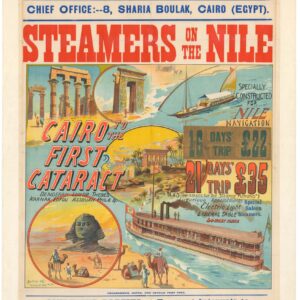A unique suite of 164 NASA ‘Red Numbered Photographs’ documenting one of the most pioneering space missions in the 1970s.
164 Red No. photographs of BUSS (Balloon-born Ultraviolet Stellar Spectrometer) mission.
$4,500
1 in stock
Description
Undoubtedly the most important and comprehensive photographic documentation of NASA’s early exploration of deep space that we have seen on the market.
This fascinating collection of official NASA ‘Red Numbered Photographs’ is housed in two official US Government photo binders and is generally in excellent condition. The 164 photographs are all printed on Kodak paper and constitute part of NASA’s official record.
The photographs document the experimental 1976 BUSS (Balloon-born Ultraviolet Stellar Spectrometer) Mission from launch to crash-site recovery. Also included are extraordinary photographs taken while the probe was in space and during its re-entry into Earth’s atmosphere.
The mission impacted the development of the NASA space program in the late 1970s and early 1980s. In addition to many technical photographs showing the module, the balloon, various launch vehicles, NASA facilities, and the crash site, the collection also contains rare photographs of the staff involved in this pioneering mission.
Context is Everything
In the spring of 1976, a team of American and Dutch scientists conducted the most successful stratospheric balloon flight to that point. The project used a balloon the size of a football field to carry the probe BUSS (Balloon-born Ultraviolet Stellar Spectrometer) into space, where it captured some of the first imagery of distant star systems. For 12 hours, the 589 kg payload was carried across the Texas night sky at 40km above the ground.
Launching the BUSS payload culminated a three-year collaboration between scientists from NASA, Houston Baptist University, and the University of Utrecht’s Space Research Laboratory. The mission aimed to use the custom-built stellar spectrometer to gather crucial information on distant giant and super-giant stars. While this particular project had been running for several years when the current launch occurred, the American-Dutch endeavor was part of a broader series of star studies instigated by NASA as far back as 1971.
Prior to this successful flight, the project had launched several balloon-borne probes, but none of them had been able to gather enough information to be deemed a success. This changed with the current mission, which the Johnson Space Center has characterized as the most successful balloon-based spatial reconnaissance mission (JSC Release 76-39). In addition to testing their experimental BUSS spectrometer, an essential part of this launch was also to assess the possibility of installing a similar system on the new Space Shuttle, which was being developed at the time.
Purpose of the BUSS mission
The probe was designed to obtain data on spectral variations of a range of stars, thus aiding scientists in determining the stars’ structure and evolution. Previous flights had received some information, but only at a fiftieth of the spectral range covered by the specially designed 1976 BUSS payload.
The BUSS system gathered information on at least sixteen giant and super-giant stars, including Arcturus, a giant in the constellation Bootes, as well as the super-giants Antares (alpha Scorpii), Vega (alpha Lyrae), and not least Spica (alpha Viriginis). The latter was identified as a super-hot star among the brightest celestial bodies observed during this mission.
The team was particularly interested in recording the super-giant Deneb in the constellation Cygnus, a goal they successfully achieved. Deneb is more than 1400 light years from our solar system, meaning that the light recorded by the BUSS spectrometer and documented in this incredible collection of photographs was emitted more before the Viking Conquest of Britain in the 9th century. The readings provided by this pioneering mission allowed the team to ascertain that Deneb was so enormous that “if the sun were located in its center, the Earth would orbit the sun entirely within the star’s outer limits.”
After completing its 12-hour flight, the BUSS package was landed by a parachute similar to the one used by the Apollo command module. As amply documented in this stunning collection, the probe, balloon, and parachutes were all retrieved by NASA engineers from the crash site located between Abilene and Fort Worth.
Composition of the Team
The BUSS project resulted from a three-year collaboration between the Johnson Space Center (JSC) under NASA, Houston Baptist University, and the Space Research Laboratory at the University of Utrecht in Holland. Dr. Yoji Kendo of the JSC led the venture, which was supported by Dr. Thomas H. Morgan and Dr. Jerry L. Modisette from Houston. Dr Cees de Jager led the Dutch team.
‘Red Numbered Photographs’
‘Red Numbered Photographs’ are one of two types of official photographic documentation used by NASA. While red numbers were printed on color photographs, monochrome photographs were equipped with a black number (known as ‘Black Numbered Photographs’). All of the photographs included in this collection are officially numbered red photos, implying that they form part of NASA’s official documentation of their missions. The numbering also means that each image can be looked up and verified in NASA’s archives.
In regard to verifying authenticity, one of the most important aspects is the watermarking of the paper by Kodak. All of our photographs carry the watermark “This paper was manufactured by Kodak.”
Cartographer(s):
Condition Description
Minor wear.
References
Johnson Space Center made an official press release about this mission following its completion (JSC Release 76-39). The results of the mission were also included in Eleanor H. Ritchie’s “Astronautics and Aeronautics, 1976. A Chronology”, published as part of The NASA History Series in 1984 (pp.115-16).







